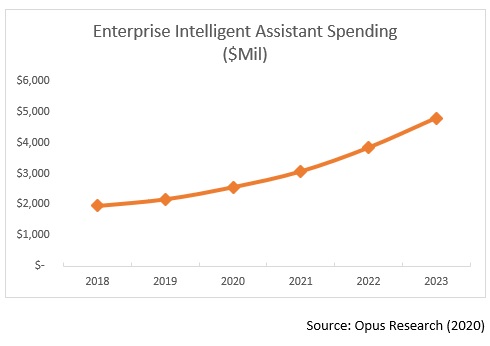2020 has the feel of an inflection point for automated virtual agents (AVAs) and enterprise intelligent assistants (EIAs), or as most people call them “bots.” The question is: Which way are we heading in IT? On the positive side, there’s upward momentum fed by an imperative to introduce elements of artificial intelligence (AI) into contact centers, mobile applications, and back-end CRM systems. Tempering these efforts are long-standing, well-understood issues involved in overcoming organizational and technological silos, not to mention determining which department’s budget pays for “AI-based solutions.”
If you or your digital transformation team has stopped to take stock of the situation, you are not alone. Over the past five years, Opus Research observed supernormal growth in spending on EIA solutions. Our census of intelligent assistant (IA) implementations, corroborated by vendor-supplied data, reflected astronomical growth in the number of bots deployed – north of 75% annually from 2016-2019 (see below graph). Growth in spending paralleled the pace of implementation, more than 70% during our census period, growing from roughly $600 million in 2016 to about $2 billion in 2018. This period of supernormal growth, driven by multiple implementations within a single firm, is giving way to a time of reflection and strategic thinking.
Yet, as we enter a new decade, there is evidence that enterprises are hitting the “pause” button. They are taking stock of far-flung, stand-alone projects, and proof of concepts, and taking time to evaluate alternative approaches and define a path forward.
The “Land and Expand” Imperative
Four years ago, choices were relatively simple and expensive. Early adopters worked with vendors to define use cases and launch IAs, subsidized by the innovation group with support from a team of departmental subject matter experts and IT. Solution providers then pursued a “land and expand strategy” to introduce additional IAs to support new use cases to demonstrate value, eventually moving to the critical path between brands and their customers.
Initiatives might start with a Q&A bot, essentially a natural language-powered front end to the company’s FAQ. Then, they might get adventurous and assign a conversational IA with the task of form filling: onboarding clients, making reservations, or providing technical support. Under this scenario, IA champions treated EIAs as digital employees. They would onboard them, train them, and then assign them a number of business-critical tasks. Firms that started with a single EIA in 2016 most likely have three or more in service as they trial different vendors or offer new use cases. That approach spelled geometric growth.
Message from Enterprise Decision Makers: Not So Fast!
It was common for the largest firms in any given vertical – aka category leaders – to launch multiple bot initiatives to determine the business value of IAs, evaluate prospective solution providers, and to gain competitive advantage by projecting the image of innovator or thought leader. All the while, these leaders could use the time to determine which solution provider best suited operational objectives, branding targets, and customer experience thresholds. Yet, in the long run, there is incentive to choose just one provider or none.
Today, many medium-to-large companies find themselves in a situation where a multiplicity of bots, intelligent assistants, or virtual agents are out of control. Shadow IT departments have charged ahead along a build-your-own-bot (BYOB) roadmap. As a result, company landing pages now have Q&A bots. Mobile apps have in-app assistants. Contact centers have morphed their IVR (interactive voice response) platform into an IVA (intelligent virtual assistant) by training a bot on existing scripts. Finally, bot support on popular messaging platforms have become a must, reflecting the preferences of more digitally-minded Gen Zers and Millennials.
Regardless of the root cause, the result is the same. The customer care, digital commerce, and employee productivity landscape is littered with IAs, each in its own silo, consulting its own sources of intelligence, and totally oblivious to one another.
Whither IA and the Contact Center? Come to Enterprise Connect to Find Out
According to Opus Research, the prime directive for an IA is as follows:
“to provide accurate answers, recommendations or actions, consistently and at scale in response to natural language input in the form of voice or text over an individual’s choice of channel and device.”
Choosing solution providers or hiring “digital employees” to achieve this directive most often falls to a team of C-level executives, which be championed by marketing, digital transformation or customer experience. Implementation, training, long-term care, and feeding always comes home to roost in the contact center, which must staff up with a mix of developers and subject matter experts that report up a chain of command, topped by either IT or operations. Solutions providers get points for providing technologies that enable companies to leverage existing investment in interactive voice response, routing, interaction management, analytics, and CRM.
How to best go about it is the key topic of discussion in the panel discussion, “
The AI-Infused Contact Center: Evaluating Your Options,” for which I will serve as moderator at Enterprise Connect-Orlando on March 30. In it, we will evaluate options for deploying natural language processing, machine learning, deep neural networking, dialog management, speech analytics, and cognitive computing to support what I termed as the prime directive, above.










